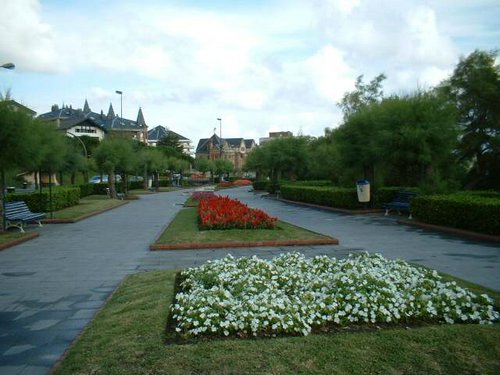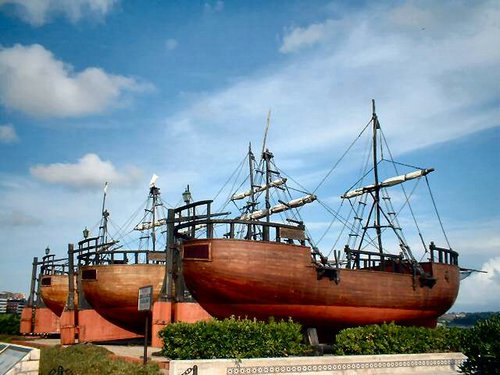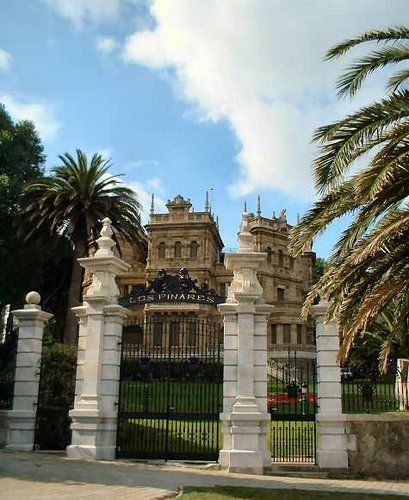
Santander is an elegant, cosmopolitan
city. It has a population of almost
200,000 inhabitants. The city is built
around the bay and beaches. The city
is full of historic buildings. The best
part of the city to visit are around
the port, the beaches, the Península
de la Magdalena and the city centre,
which is mainly a commercial area. The
main street in the centre is Juan
de Herrera which goes to Cuatro
Caminos (the area with most shops).
.jpg)
In the area around the port known as Muelle de Salmerón,
there is a sculpture called the Grúa
de Piedra which dates back to 1900;
the Palacete del Embarcadero is an old mansion from where you can
take a boat trip around the bay in the
summer, (Las Reginas, Pº Marítimo,
Tel: 942 216 753); los Raqueros - various sculptures grouped together;
the Playa del Sardinero,
this beach became famous in the 20's
when royalty and the jet set spent summers
there. There are lots of bars and restaurants
with terraces to sit out on in the port
area which makes it a great place to
soak up the atmosphere. There is a Casino
near the port too; Puerto Chico,
is what used to be the port but is now
the marina where there are also lots
of bars and small restaurants, busy
during the summer months, where you
can eat very good typical fish and seafood
dishes. The Paseo de Pereda,
a promenade given special historic and
artistic status, was designed by an
Englishman, Jorge Borrow, in 1837. It
is made up of French 18th - 19th century
style mansions and goes parallel to
the Muelle de Salmerón between Puerto Chico and Las
Farolas, where the headquarters of the
Santander bank are; the Palacio de
Festivales is in the Pereda gardens.
Castles and Palaces
in Santander

- Palacio
de la Magadalena: This palace
was built in 1912 using public funds
and given to Alfonso XIII and Victoria
Eugenia who used it as a summer home
from 1913 to 1930. It is located within
25 hectares of forests. The Royal
quays (el Embarcadero Real), the lighthouse,
the exhibition centre, a childrens'
playground, a monument commemorating
Felix Rodriguez de la Fuente, the
Assembley Rooms, the Royal Stables
and la Playa del bikini (a
beach).
Nowadays the building is used by the International University of Menédez
Pelayo (UIMP) which holds summer
courses in literature and Spanish
culture and language for foreigners.
- Palacio de Pronillo: Located
in Ciudad Jardín. In
the 16th century this Renaissance
style palace belonged to the Riva-Herrera
family. This family became well known
for their participation in the discovery
of America.
- Castillo de San Felipe: This
used to be a defensive fort in the
middle ages. However, the castle no
longer exists. The bank of Spain was
built on its remains.
 Cathedrals and churches
in Santander:
Cathedrals and churches
in Santander:
- Cathedral
de la Asunción de la Virgen (in the arched square): Since
Roman times it has been reformed several
times. In 791, when Santander belonged
to the Castilla kingdom, king Alfonso
II, built a PreRoman church where
the Romans had built their city called Portus Victoriae. In 1187 Alfonso
VIII converted it into Roman abbey.
In the 8th century the crypt and basilica
were built. In the 14th century the
Gothic style cathedral was built.
It has been a national monument since
1931.
- Iglesia de la Compañía
or Iglesia de la Anunciación (in the arched square): Built by the
company of Jesús. Renaissance.
- Convento de Santa Cruz: Built
in 1641. Renaissance.
- Iglesia de la Consolación:
Built in the 15th century. Baroque.
- Iglesia de Santa Lucia: Renaissance
and early Christian, by Antonio de
Zabaleta, in 1868.
- Monasterio de Corbán:
Located on the outskirts of the city,
built in the 15th century. The church
and cloister have been preserved.
Museums in Santander:
- Museo Municipal de Bellas Artes:
This museum has 3 floors of paintings,
sculptures, etchings and drawings
by contemporary artists from Cantabria.
Visitors start their visit on the
top floor and work their way down.
- Casa-Museo
Menéndez Pelayo: The writer
Menéndez Pelayo and the novelist
José Mª de Pereda both
helped build this important library
which has over 42,00 books in its
collection. It was first opened by
Alfonso XIII. The house where Menedez
Pelayo lived with his family is within
the grounds. It contains some of his
personal possesions, his bedroom has
been preserved. It was given special
cultural status in 1982.
- Museo Marítimo del Cantábrico:
This museum is divided into several
sections: marine biology, maritime
history, maritime technology, the
history of fishing in the region...
- Museo Regional de Prehistoria
y Arqueología: This is
an exhibition of Prehistoric art from
Cantabria, the section on Stoneage
art is particularly good.
- Planetario: This planetarium
investigates the sun, the planets,
the stars and the heavens.
- Centro Cultural Modesto Tapia:
This is an exhibition centre made
up of 2 rooms on 2 floors. The Sardinero
room only has exhibitions while the
La Bahía room holds workshops
as well as exhibitions.
- Fundación Emilio Botín:
This was founded in 1964 for social,
educative and cultural events.
- Fundación Marcelino Botín:
This was opened in 2006; It is used
as an exhibition centre.
Where to stay in
Santander: See hotels
in Santander or search for a
suitable hotel in the box on the right.
 Santander (Capital of the province of Cantabria)
Santander (Capital of the province of Cantabria) 
.jpg)

 Cathedrals and churches
in Santander:
Cathedrals and churches
in Santander: